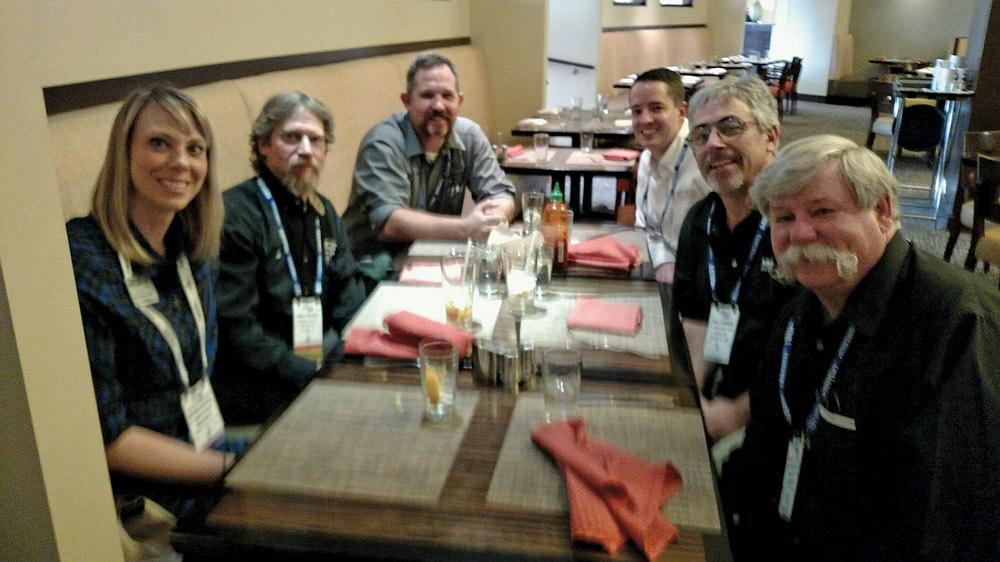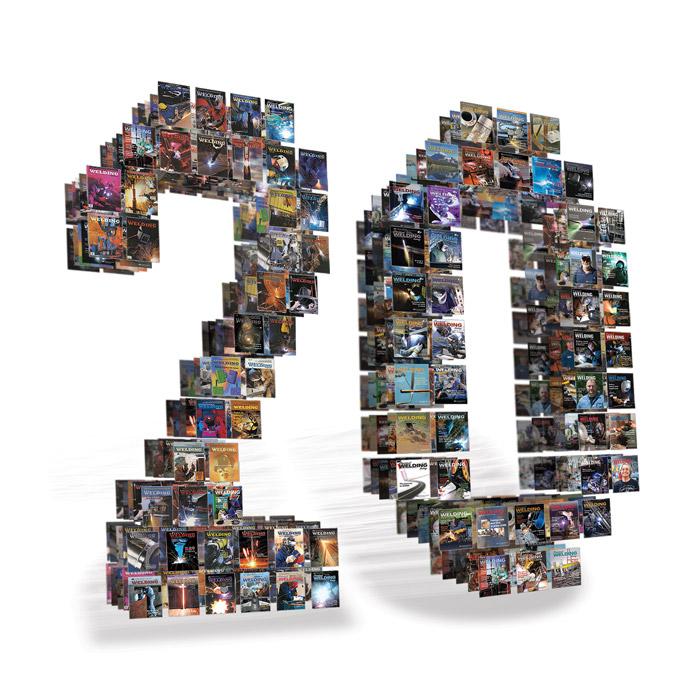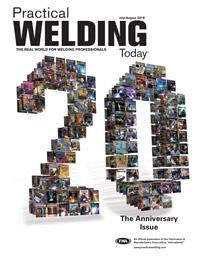- FMA
- The Fabricator
- FABTECH
- Canadian Metalworking
Categories
- Additive Manufacturing
- Aluminum Welding
- Arc Welding
- Assembly and Joining
- Automation and Robotics
- Bending and Forming
- Consumables
- Cutting and Weld Prep
- Electric Vehicles
- En Español
- Finishing
- Hydroforming
- Laser Cutting
- Laser Welding
- Machining
- Manufacturing Software
- Materials Handling
- Metals/Materials
- Oxyfuel Cutting
- Plasma Cutting
- Power Tools
- Punching and Other Holemaking
- Roll Forming
- Safety
- Sawing
- Shearing
- Shop Management
- Testing and Measuring
- Tube and Pipe Fabrication
- Tube and Pipe Production
- Waterjet Cutting
Industry Directory
Webcasts
Podcasts
FAB 40
Advertise
Subscribe
Account Login
Search
Welding trends, technology advancements, and tales
PWT Editorial Advisory Committee members look back on the last 20 years
- By Amanda Carlson
- July 19, 2016
- Article
- Arc Welding
How do you condense almost two decades’ worth of welding history into one article? How do you narrow it down to include all of the necessary milestones, turning points, the lows, and the highs? The short answer is you can’t. Welding, like anything else, has expanded and changed significantly thanks to research and development initiatives that have touched everything from the welding processes themselves, the equipment that makes welding possible, and the materials that we weld to the men and women who perform the task.
There is so much to choose from that to even try to include it all would be incredibly difficult if not impossible. Plus, everyone’s opinion of what constitutes a significant development in welding technology varies depending on where and how you use welding.
Last November members of the Practical Welding Today® Editorial Advisory Committee sat down with one another and discussed their thoughts on the biggest technological advancements within the welding industry over the last 20 years. The responses were as different as the individuals providing them. The gentlemen that were present represent a wide array of industry sectors and personal backgrounds.
Committee members present were Daniel Galiher, senior corporate welding engineer at Tower Intl., Livonia, Mich.; Daniel Turner, welding instructor at Yuba College, Marysville, Calif.; James Mosman, chair of the Industrial Tech department at Odessa College, Odessa, Texas; Paul Cameron, CWI and NDE Tech at Braun Intertec and Arc Welding 101 columnist, Rochester, Minn.; and Warren Long, commodity manager, Briggs & Stratton Corp., Wauwatosa, Wis.
They touched on their own personal job experience and how technology has affected what they do; they discussed skilled workers and the next generation of welders; but mostly they just talked shop. What are the challenges they face in their jobs? How can feedback from others in different industries help them address those challenges? Though most of these men had never met one another, they had at least one common thread among them: their love for welding.
PWT: Power sources have undergone a significant transformation over the last 20 years. What is your take on the progression that has taken place with these machines?
Mosman: For me, the biggest thing has been the transition from transformer machines to inverters in welding power sources. I’ve got a shop full of inverters now. One machine has 300 pre-programs on it. And then I have a 1965 Lincoln with one program—you turn it on. That’s where I learned, on the old round-top Lincolns. Now it’s different. I’ve been trying to find some of these older machines because I show my advance processes group where it all started.
Turner: Absolutely. But it’s funny, I’ve dealt with some instructors that said, “I’m not going to go with inverters.” I said, “Why not?” They said, “They weld weird. They sound funny. I can’t deal with the chirping sounds.”
Cameron: Some of these new power sources are idiot-proof, and there’s nothing wrong with that. I’m a freak on process control. I’ve been a welding engineer since about 1996 and what I found was welding was the last totally uncontrolled manufacturing process. You counted on whomever that guy was operating that equipment. So even though you may have had a weld procedure, you didn’t always know if it was being followed. This new technology can help make that happen.
Back when I worked for a railcar manufacturer, I was constantly on the floor trying to help welders with a problem, but I found that most of the time I would only need to set the wire feed speed and voltage to within the weld parameters to get them back on track. When I found out I could just program the power source with the desired parameters, I went out and installed a program that let the machine run only within a specific range for wire feed speed and a specific range for voltage.

PWT Editorial Advisory Committee members met at FABTECH and talked shop. Clockwise starting at the far left: Amanda Carlson, Jim Mosman, Dan Turner, Warren Long, Paul Cameron, and Daniel Galiher.
I did this in four major manufacturers where I’ve worked and found that the first year was sheer hell. Welders didn’t like it, and I was on the hook for every welding problem. But after that first year, welders didn’t want to use a power source that hadn’t been programmed. So, I’ve found that the biggest plus to these high-tech power sources, at least from a weld engineer’s standpoint, is the ability to control the process.
Galiher: We have the ability to lock out our welding schedules, especially for robotic applications. We will lock them out because we want only authorized welding technicians and engineers making changes. When changes are made to a weld, it has to be validated again for weld quality.
PWT: Do you think these machines that do all of the thinking for you will do welders a disservice in the future?
Turner: I think there’s two ways to answer that question. The first answer is yes, it does hurt them a bit because on the new machines you can adjust the voltage and wire feed speed together. This makes it tough for students to understand how to adjust each one separately or remember what each one does on its own. But on the flip side, you could argue that using these machines doesn’t hurt them because this is what they’ll work with once they get out in industry. We as educators have to find that balance and make sure we give students the welding theory they’ll need, but also provide them with equipment that they’ll be using on the job. So the answer is yes and no.
Long: From a manufacturing perspective, with fewer and fewer people interested in the skilled trades, the level of talent coming in the door seems to be going down. If you get a standard proc-ess that you can program, it is critical from our perspective because we can work with varying levels of talent and speed up training.
Mosman: I think what we’ve done in the last 20 years is we’ve made a simple process supercomplicated for the people who don’t need any added complications. Or we’ve made it real simple for the ones who do understand it and want to change a couple of parameters. I don’t think they’ve found that happy medium yet.
PWT: Besides inverter technology, what other advancements have had a significant effect on the welding industry?
Mosman: One thing that has been huge over the last 10 years especially is the virtual welding—where it started from the time it was being used by the U.S. Army to where we’re at with it now. I wonder where it’s going to go.
Cameron: You can’t teach everything with the virtual welder, but there are some things they do great. I used one when I was a quality manager, and it was certainly the tool that stopped me from grabbing a guy’s hands and yelling into the back of his hood. You can run a bead and show the rest of the class on a big screen what happens when he changes his gun angle, push/pull angle, or stickout.
Turner: The replay function is awesome because I’ll have people argue with me when I told them what their mistake was. They’ll say, “I did not, I did not!” and then I hit the replay button and say, “Oh yes you did.” My favorite is when I get someone who has been welding for 20 years and I watch them and realize that they have developed habits throughout their career that are probably hurting them without them realizing it. The replay function allows them to see those habits firsthand, and little by little they start changing and improving. On the flip side, there have been plenty of times when I have watched someone doing something awesome through the virtual welding and I learn from them and become a better welder as a result.
Cameron: You can yell into their hood all you want or hold their hand—I used to grab their hand and it would look like I was hugging them. And then they’d get through welding and swear it was an acceptable weld. Then it’s like an epiphany and they see the results.
PWT: What effect is the skilled-worker shortage having on your schools or in your shops?
Galiher: The welding engineers we hire at our company don’t stay welding engineers for very long. They move up the ladder and it breaks my heart. They go into other leadership or project management positions because they want to move up the ladder, and I don’t blame them. Myself, my core life’s work is welding, and I don’t want to do anything else but that. But I too want to advance in my career. I just think industry needs to provide a vertical promotion system that lets you be who you want to be but still be able to climb up your ladder. Maybe this way so many talented welding engineers would not stray from their welding career path.
Turner: I do a lot of work with companies, and the No. 1 thing is it’s really expensive to train people. I say, “You think that’s expensive? Try not training them.”
About the Author

Amanda Carlson
2135 Point Blvd
Elgin, IL 60123
815-227-8260
Amanda Carlson was named as the editor for The WELDER in January 2017. She is responsible for coordinating and writing or editing all of the magazine’s editorial content. Before joining The WELDER, Amanda was a news editor for two years, coordinating and editing all product and industry news items for several publications and thefabricator.com.
About the Publication
subscribe now

The Welder, formerly known as Practical Welding Today, is a showcase of the real people who make the products we use and work with every day. This magazine has served the welding community in North America well for more than 20 years.
start your free subscription- Stay connected from anywhere

Easily access valuable industry resources now with full access to the digital edition of The Fabricator.

Easily access valuable industry resources now with full access to the digital edition of The Welder.

Easily access valuable industry resources now with full access to the digital edition of The Tube and Pipe Journal.
- Podcasting
- Podcast:
- The Fabricator Podcast
- Published:
- 04/16/2024
- Running Time:
- 63:29
In this episode of The Fabricator Podcast, Caleb Chamberlain, co-founder and CEO of OSH Cut, discusses his company’s...
- Industry Events
16th Annual Safety Conference
- April 30 - May 1, 2024
- Elgin,
Pipe and Tube Conference
- May 21 - 22, 2024
- Omaha, NE
World-Class Roll Forming Workshop
- June 5 - 6, 2024
- Louisville, KY
Advanced Laser Application Workshop
- June 25 - 27, 2024
- Novi, MI
































